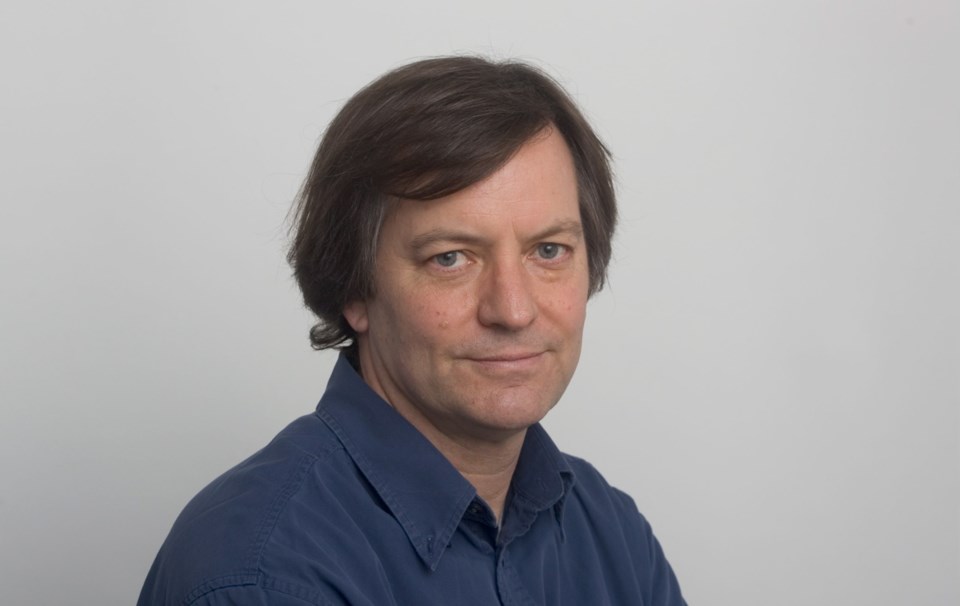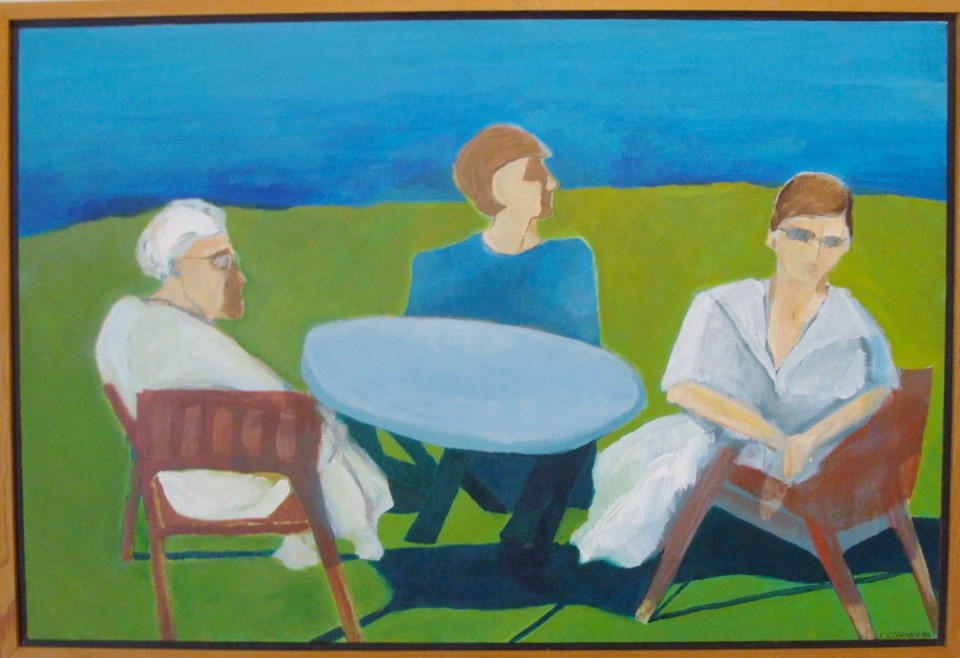 Bonnie Laird and Suzanne Bessette made a selection of paintings from the estate of Karin Koerner (1928-2005) for an exhibition of her work at the ArtWorks studio at the Garth Homer Centre. I met them there, with Koerner’s son Stephen, to discuss Koerner and her work.
Bonnie Laird and Suzanne Bessette made a selection of paintings from the estate of Karin Koerner (1928-2005) for an exhibition of her work at the ArtWorks studio at the Garth Homer Centre. I met them there, with Koerner’s son Stephen, to discuss Koerner and her work.
“We liked the waterlilies,” Bessette said, indicating Koerner’s paintings of the pond at her home at Queenswood. Koerner’s paintings had hung, in their time, in the Sooke Fine Arts show, the Fran Willis Gallery and at a solo presentation at the Art Gallery of Greater Victoria’s art rental. One of the paintings shows the crowd at an art opening, and another shows three people sitting on lawnchairs.
“That’s my sister Marianne,” Stephen pointed out. “She’s the one with the glasses.” Other paintings include Koerner’s self-portrait, a view of Sweden and a portrait of her son Jamie.
“Jamie was a member here,” Laird noted, referring to the ArtWorks program. One of his paintings is included in the show.
Karin Viksten Koerner was born in Sweden in 1928. Her family was very sympathetic to culture, and the children grew up painting and drawing. She met her husband in Sweden when he was on a marketing trip for his family’s forest products business, and emigrated in 1949 to Vancouver. Right away, Karin got involved in art there, studying with Lawren Harris. To be on location with the forest industry, the Koerners then lived in Port McNeill, Cowichan Lake and Jordan River.
“She knew Vancouver Island very well,” Stephen said.
“My dad was at Gordon Head base in the Canadian Army during the war,” he continued, “and always wanted to come back.”
When he realized that dream, Karin enrolled in the Victoria College of Art. The influence of Jim Gordaneer, one of her teachers, is evident in her paintings.
The Koerners had three children, and the youngest, Jamie, is developmentally disabled. Because Karin had seen engaged-art programs for the disabled in Sweden and in San Francisco, she brought her energies to bear locally. The Garth Homer Centre originated in 1976, and Jamie began coming there in 1992.
Koerner’s advocacy led her to a role on the board and, soon after, to the initiation of the art program she hoped for. Staff member Laird was hired, soon joined by Bessette. After years in a less-than-perfect space, through ArtWorks fundraising activities, in 2009 they opened the doors to the splendid Karin Koerner Gallery and studios.
ArtWorks is not babysitting or daycare. Some clients show up to work five days a week, though the minimum requirement is two.
“We expect them to develop a body of work, to have enough for an exhibition and to fully participate,” Laird explained.
“We’re mentoring, coaching, instructing — as needed,” Bessette added. This is not a classroom, but a workplace that provides art supplies and help with accessibility. “We call it a supportive studio.”
A dozen artists, each with a unique style, have been working here diligently for years. What will it lead to? The artists have had reciprocal exhibits with other art groups in Scotland, Australia and the U.S.
Locally, they studied with photographer Ian Macallister and created artworks inspired by his photos of the Great Bear Rainforest. He then did a lecture series and book launch at the ArtWorks gallery, which was a standing-room-only event.
It’s a lovely small gallery, opening out from the dedicated studio areas with central supplies of acrylic paints. Artists using markers have individual collections of a huge range of coloured pens. There is also a comfortable place for library, archives and computer-art projects. It took a lot of fundraising and the donation of many in-kind services to put this together, and one of the artists described it to me as “a little piece of heaven.”
Butchart Gardens was a major sponsor of the renovation, and the ArtWorks group recently held an exhibition at the Gardens.
The most generous support for the studio and gallery came from the Koerners.
“It is a joy to come to work because of the space,” Laird said. “This is a legacy that Karin left us.”
Many people who were formerly marginalized have gained a new sense of identity in this program.
“They identify as artists, for sure,” Bessette agreed. Everyone at Garth Homer knows about the ArtWorks program, through art works hanging in the public areas. In the wider community, many of the artists have become known through the attractive invitations ArtWorks sends out.
“People follow certain artists, and come to the shows to purchase and collect,” Laird said. “Of course, we always see the family and friends, but word gets around and new people show up every time.” ArtWorks is a regular exhibitor at the Martin Batchelor Gallery and at the annual Moss Street Paint-In.
After viewing Karin Koerner’s paintings, I looked in on some of the resident artists, hard at work on themed paintings celebrating sa���ʴ�ý’s 150th anniversary. They had visited a recent Tim Hoey exhibition at the Trounce Alley Gallery and were inspired to paint distinctly Canadian objects — Old Dutch potato chips, maple-leaf shaped cookies and a Tim Hortons coffee cup.
ArtWorks member Ashleigh Fraser was inspired by a rendering of the provincial floral emblems.
“I kind of put my own twist on it,” she told me. “Not exactly like it, but pretty close.”
Beautiful, I’d say.
Long may the Karin Koerner Gallery continue its good work.
��
Retrospective of Paintings by Karin Koerner, at ArtWorks Karin Koerner Gallery, Garth Homer Society, 813 Darwin Ave., 250-475-2270, until May 3.



